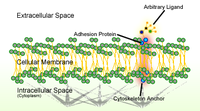
Photo from wikipedia
Background and Aim: Leukocyte adhesion deficiency type 1 is a rare, autosomal recessive disorder that results from mutations in the ITGB2 gene. This gene encodes the CD18 subunit of &bgr;2… Click to show full abstract
Background and Aim: Leukocyte adhesion deficiency type 1 is a rare, autosomal recessive disorder that results from mutations in the ITGB2 gene. This gene encodes the CD18 subunit of &bgr;2 integrin leukocyte adhesion cell molecules. Leukocyte adhesion deficiency type 1 is characterized by recurrent bacterial infections, impaired wound healing, inadequate pus formation, and delayed separation of the umbilical cord. Materials and Methods: Blood samples were taken from 13 patients after written consent had been obtained. Genomic DNA was extracted, and ITGB2 exons and exon-intron boundaries were amplified by polymerase chain reaction. The products were examined by Sanger sequencing. Results: In this study, 8 different previously reported mutations (intron7+1G>A, c.715G>A, c.1777 C>T, c.843del C, c.1768T>C, c.1821C>A, Intron7+1G>A, c.1885G>A) and 2 novel mutations (c.1821C>A; p.Tyr607Ter and c.1822C>T; p.Gln608Ter) were found. Conclusions: c.1821C>A (p.Tyr607Ter) and c.1822C>T (p.Gln608Ter) mutations should be included in the panel of carrier detection and prenatal diagnosis.
Journal Title: Journal of Pediatric Hematology/Oncology
Year Published: 2019
Link to full text (if available)
Share on Social Media: Sign Up to like & get
recommendations!